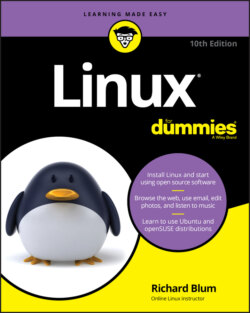Читать книгу Linux For Dummies - Richard Blum - Страница 29
Partitioning using Windows tools
ОглавлениеIf you already have Windows installed on the entire hard drive, you'll need to shrink that partition down so there's room for Linux. The first step is to check your existing hard drive for how much free space is available to dedicate for Linux. You can do that using the File Explorer tool in Windows by following these steps:
1 Open File Explorer by clicking the folder icon in the taskbar, or typing file explorer in the search area in the taskbar and selecting File Explorer from the search results.
2 When File Explorer opens, click This PC on the left-hand side of the window.This displays the status of the various storage devices you have connected to your PC. Figure 2-1 shows an example of what you might see in File Explorer.
The example shown in Figure 2-1 shows a single hard drive connected to the PC (assigned as drive letter C). File Explorer shows the drive is 899GB in size, and has 483GB available for use as a second partition.
FIGURE 2-1: The Windows 10 File Explorer window.
It's usually not a good idea to allocate all the free space on your hard drive to Linux; you'll want to leave some extra room in the Windows partition so you can continue doing things while you're running Windows, such as downloading and installing patches or saving new files.
After you determine how much space you want to dedicate to Linux, you're ready to partition the hard drive.
The Windows utility you want to use is the Disk Manager program. Follow these steps to use it:
1 Right-click the Start icon in the taskbar.
2 From the menu that appears, choose Disk Management.The Disk Management dialog box appears as shown in Figure 2-2. The dialog box shows all the hard drives installed on the PC, along with the partitions for each one.FIGURE 2-2: The Windows 10 Disk Management tool.
3 Right-click the partition that indicates it is assigned as a Windows partition and assigned a drive letter (usually the C drive).You can click either the partition entry in the text list, or the graphical picture of the partition. As shown in Figure 2-2, many modern PCs create one or more hidden partitions that aren't assigned drive letters in Windows. These partitions don't appear in File Explorer, but are used by the PC to contain recovery data to reinstall Windows in an emergency. Don't mess with those partitions!
4 Select Shrink Volume from the pop-up menu.The Shrink Volume dialog box appears, as shown in Figure 2-3.FIGURE 2-3: The Shrink Volume dialog box.
5 Enter the amount of space you want to assign to the Linux partition in the text box.Note that the entry is in MB (megabytes) instead of GB (gigabytes). One gigabyte is equal to 1024 megabytes, so just multiply the available GB space value by 1024 to get the MB value to enter here.
6 Click Shrink.
During the shrink process Windows tries to move any data stored near the end of the partition towards the front to make room for the new partition. However, some system files can't be moved, which may cause a problem and produce an error message. If this happens there are ways to move those files, but it gets much more complicated that what I can cover here. Fortunately, you aren't the first person to need to do this, so there's plenty of help available. One place to consult is the Microsoft Windows forum at answers.microsoft.com and you'll see lots of postings on how to handle this situation.
When the shrink process completes, a new partition appears in the Disk Manager listing. This new partition appears as Unassigned, and not have a drive letter assigned to it by Windows.
If you have lots of space available on your existing Windows partition you'll probably want a lot more than 10GB of space. The 10GB is the minimum recommended for most Linux distributions to fit the operating system. However, if you download lots of multimedia, you'll quickly eat up whatever was left after you installed your software! Give Linux as much space as you think you can spare from your Windows environment.
